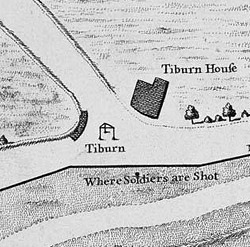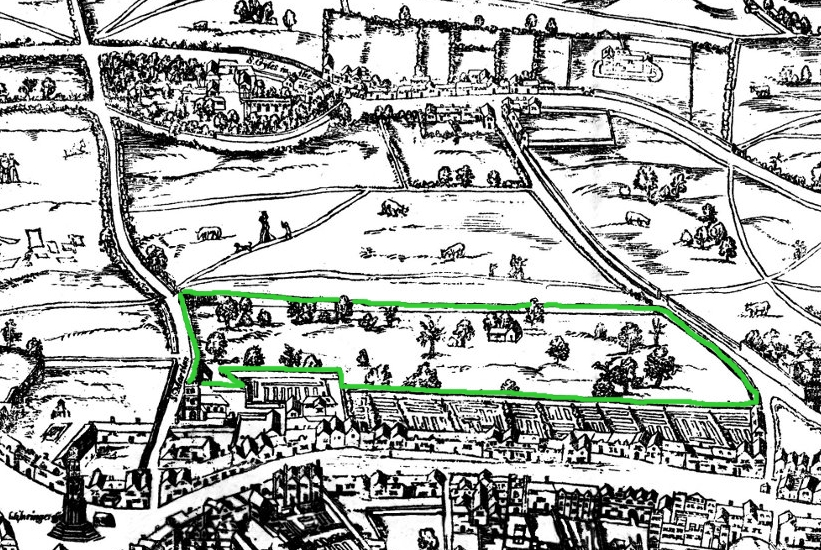|
St. Giles, London
St Giles is an area in the West End of London in the London Borough of Camden. It gets its name from the parish church of St Giles in the Fields. The combined parishes of St Giles in the Fields and St George Bloomsbury (which was carved out of the former) were administered jointly for many centuries; leading to the conflation of the two, with much or all of St Giles usually taken to be a part of Bloomsbury. Points of interest include the church of St Giles in the Fields, Seven Dials, the Phoenix Garden and St Giles Circus. History There has been a church at St Giles since Saxon times, located beside a major highway.''London: A Biography'' (2000) Ackroyd, Peter Chatto and Windus p131-140 The hospital of St Giles, recorded c. 1120 as ''Hospitali Sancti Egidii extra Londonium'' was founded, together with a monastery and a chapel, by Queen Matilda, wife of Henry I. St Giles (c. 650 – c. 710) was the patron saint of lepers and the hospital was home to a leper colony, the site ... [...More Info...] [...Related Items...] OR: [Wikipedia] [Google] [Baidu] |
Holborn And St Pancras (UK Parliament Constituency)
Holborn and St Pancras () is a parliamentary constituency in Greater London that was created in 1983. It has been represented in the House of Commons of the Parliament of the United Kingdom since 2015 by Sir Keir Starmer, the current Leader of the Labour Party and Leader of the Opposition. Constituency profile The seat of Holborn and St Pancras as drawn in 2010 is composed of all but a small western portion of the London Borough of Camden and extends from most of Covent Garden and Bloomsbury in the heart of the West End of London through other areas of the NW1 postal district, north and in elevation terms upwards through fashionable and economically diverse Camden Town to the affluent suburb of Highgate in a long strip. Gospel Oak, particularly towards Kentish Town, has high deprivation levels, but the neighbouring Highgate ward has low deprivation levels. The south part of the seat includes the University of London and several teaching hospitals, and so the constituen ... [...More Info...] [...Related Items...] OR: [Wikipedia] [Google] [Baidu] |
Reformation
The Reformation (alternatively named the Protestant Reformation or the European Reformation) was a major movement within Western Christianity in 16th-century Europe that posed a religious and political challenge to the Catholic Church and in particular to papal authority, arising from what were perceived to be errors, abuses, and discrepancies by the Catholic Church. The Reformation was the start of Protestantism and the split of the Western Church into Protestantism and what is now the Roman Catholic Church. It is also considered to be one of the events that signified the end of the Middle Ages and the beginning of the early modern period in Europe.Davies ''Europe'' pp. 291–293 Prior to Martin Luther, there were many earlier reform movements. Although the Reformation is usually considered to have started with the publication of the '' Ninety-five Theses'' by Martin Luther in 1517, he was not excommunicated by Pope Leo X until January 1521. The Diet of Worms of May 152 ... [...More Info...] [...Related Items...] OR: [Wikipedia] [Google] [Baidu] |
Dyott Street
Dyott is a surname. Notable people with the surname include: * Anthony Dyott, English lawyer and politician who sat in the House of Commons between 1601 and 1614 * George Dyott, British pioneer aviator and explorer of the Amazon * Richard Dyott (other), any of four different British politicians {{surname ... [...More Info...] [...Related Items...] OR: [Wikipedia] [Google] [Baidu] |
St Giles High Street
St Giles is an area in the West End of London in the London Borough of Camden. It gets its name from the parish church of St Giles in the Fields. The combined parishes of St Giles in the Fields and St George Bloomsbury (which was carved out of the former) were administered jointly for many centuries; leading to the conflation of the two, with much or all of St Giles usually taken to be a part of Bloomsbury. Points of interest include the church of St Giles in the Fields, Seven Dials, the Phoenix Garden and St Giles Circus. History There has been a church at St Giles since Saxon times, located beside a major highway.''London: A Biography'' (2000) Ackroyd, Peter Chatto and Windus p131-140 The hospital of St Giles, recorded c. 1120 as ''Hospitali Sancti Egidii extra Londonium'' was founded, together with a monastery and a chapel, by Queen Matilda, wife of Henry I. St Giles (c. 650 – c. 710) was the patron saint of lepers and the hospital was home to a leper colony, the site ... [...More Info...] [...Related Items...] OR: [Wikipedia] [Google] [Baidu] |
Tottenham Court Road
Tottenham Court Road (occasionally abbreviated as TCR) is a major road in Central London, almost entirely within the London Borough of Camden. The road runs from Euston Road in the north to St Giles Circus in the south; Tottenham Court Road tube station lies just beyond the southern end of the road. Historically a market street, it became known for selling electronics and white goods in the 20th century. The street takes its name from the manor (estate) of ''Tottenham Court'', whose lands lay toward the north and west of the road, in the parish of St Pancras. ''Tottenham Court'' was not directly connected to the district of Tottenham in the London Borough of Haringey. Geography Tottenham Court Road runs from Euston Road in the north, to St Giles Circus (the junction of Oxford Street and Charing Cross Road) at its southern end. The road lies almost entirely within the London Borough of Camden near its boundary with the City of Westminster, a distance of about three-quarters of ... [...More Info...] [...Related Items...] OR: [Wikipedia] [Google] [Baidu] |
Great Russell Street
Great Russell Street is a street in Bloomsbury, London, best known for being the location of the British Museum. It runs between Tottenham Court Road (part of the A400 route) in the west, and Southampton Row (part of the A4200 route) in the east. It is one-way only (eastbound) between its western origin at Tottenham Court Road and Bloomsbury Street. The headquarters of the Trades Union Congress is located at Nos. 23–28 (Congress House). The street is also the home of the Contemporary Ceramics Centre, the gallery for the Craft Potters Association of Great Britain; as well as the High Commission of Barbados to the United Kingdom. The Queen Mary Hall and YWCA Central Club, built by Sir Edwin Lutyens between 1928 and 1932, was at No 16-22 (it is now a hotel). Famous residents Great Russell Street has had a number of notable residents, especially during the Victorian era, including: * W. H. Davies (1871–1940), poet and writer, lived at No. 14 (1916–22). * Randolph Calde ... [...More Info...] [...Related Items...] OR: [Wikipedia] [Google] [Baidu] |
Rookery (slum)
A rookery is a colloquial English term given in the 18th and 19th centuries to a city slum occupied by poor people and frequently also by criminals and prostitutes. Such areas were overcrowded, with low-quality housing and little or no sanitation. Local industry such as coal plants and gasholders polluted the rookery air. Poorly constructed dwellings, built with multiple stories and often crammed into any area of open ground, created densely-populated areas of gloomy, narrow streets and alleyways. By many, these parts of the city were sometimes deemed "uninhabitable". Etymology The term rookery originated because of the perceived similarities between a city slum and the nesting habits of the rook, a bird in the crow family. Rooks nest in large, noisy colonies consisting of multiple nests, often untidily crammed into a close group of treetops called a rookery. The word might also be linked to the slang expression ''to rook'' (meaning to cheat or steal), a verb well established ... [...More Info...] [...Related Items...] OR: [Wikipedia] [Google] [Baidu] |
Tyburn
Tyburn was a manor (estate) in the county of Middlesex, one of two which were served by the parish of Marylebone. The parish, probably therefore also the manor, was bounded by Roman roads to the west (modern Edgware Road) and south (modern Oxford Street), the junction of these was the site of the famous Tyburn Gallows (known colloquially as the "Tyburn Tree"), now occupied by Marble Arch. For this reason, for many centuries, the name Tyburn was synonymous with capital punishment, it having been the principal place for execution of London criminals and convicted traitors, including many religious martyrs. It was also known as 'God's Tribunal', in the 18th century. Tyburn took its name from the Tyburn Brook, a tributary of the River Westbourne. The name Tyburn, from Teo Bourne, means 'boundary stream',Gover, J. E. B., Allen Mawer and F. M. Stenton ''The Place-Names of Middlesex''. Nottingham: English Place-Name Society, The, 1942: 6. but Tyburn Brook should not be confused wit ... [...More Info...] [...Related Items...] OR: [Wikipedia] [Google] [Baidu] |
Holborn
Holborn ( or ) is a district in central London, which covers the south-eastern part of the London Borough of Camden and a part ( St Andrew Holborn Below the Bars) of the Ward of Farringdon Without in the City of London. The area has its roots in the ancient parish of Holborn, which lay on the west bank of the now buried River Fleet, taking its name from an alternative name for the river. The area is sometimes described as part of the West End of London or of the wider West London area. The River Fleet also gave its name to the streets ''Holborn'' and ''High Holborn'' which extend west from the site of the former Newgate in the London Wall, over the Fleet, through Holborn and towards Westminster. The district benefits from a central location which helps provide a strong mixed economy. The area is particularly noted for its links to the legal profession, the diamond centre at Hatton Garden and Great Ormond Street Hospital. Origins and administration Holborn emerged from th ... [...More Info...] [...Related Items...] OR: [Wikipedia] [Google] [Baidu] |
Neal's Yard
Neal's Yard is a small alley in London's Covent Garden between Shorts Gardens and Monmouth Street which opens into a courtyard. It is named after the 17th century developer, Thomas Neale. In 1976, alternative activist and entrepreneur Nicholas Saunders established the bulk Whole Food Warehouse; he had bought 2 Neal's Yard, a derelict warehouse previously used by the former Covent Garden fruit and vegetable market, for £7,000 a few years earlier. From this success, grew other enterprises in other buildings such as Neal's Yard Apothecary (now known as Neal's Yard Remedies), Neal's Yard Bakery, Monmouth Coffee Company and Neal's Yard Dairy Neal's Yard Dairy is a London artisanal cheese retailer, wholesaler and (formerly) cheesemaker in London, which was founded in 1979. It has been described as "London's foremost cheese store." History Neal's Yard Dairy was founded in 1979 by ..., The area now contains several other health-food cafes and retailers. References Exter ... [...More Info...] [...Related Items...] OR: [Wikipedia] [Google] [Baidu] |
Neal Street
Covent Garden is a district in London, on the eastern fringes of the West End, between St Martin's Lane and Drury Lane. It is associated with the former fruit-and-vegetable market in the central square, now a popular shopping and tourist site, and with the Royal Opera House, itself known as "Covent Garden". The district is divided by the main thoroughfare of Long Acre, north of which is given over to independent shops centred on Neal's Yard and Seven Dials, while the south contains the central square with its street performers and most of the historical buildings, theatres and entertainment facilities, including the London Transport Museum and the Theatre Royal, Drury Lane. The area was fields until briefly settled in the 7th century when it became the heart of the Anglo-Saxon trading town of Lundenwic, then abandoned at the end of the 9th century after which it returned to fields. By 1200 part of it had been walled off by the Abbot of Westminster Abbey for use as arable land ... [...More Info...] [...Related Items...] OR: [Wikipedia] [Google] [Baidu] |
Thomas Neale
Thomas Neale (1641–1699) was an English project-manager and politician who was also the first person to hold a position equivalent to postmaster-general of the North American colonies. Neale was a Member of Parliament for thirty years, Master of the Mint and the Transfer Office, Groom of the Bedchamber, gambler, and entrepreneur. His wide variety of projects included the development of Seven Dials, Shadwell, East Smithfield, and Tunbridge Wells, land-drainage projects, steel foundries and paper-making enterprises, mining in Maryland and Virginia, raising shipwrecks, and developing a pair of dice to prevent cheating at gaming. He was also the author of numerous tracts on coinage and fund-raising, and he was involved in the idea of a National Land Bank, the precursor of the Bank of England. Biography He was the only son of Thomas Neale of Warnford, Hampshire by Lucy, the daughter of Sir William Uvedale of Wickham, Hampshire and educated at Clare College, Cambridge. Neale was ... [...More Info...] [...Related Items...] OR: [Wikipedia] [Google] [Baidu] |


.jpg)





